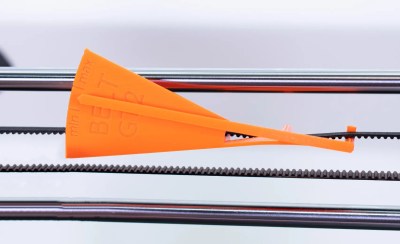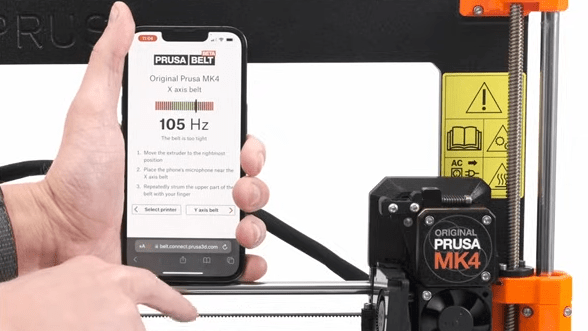Belts on a 3D printer should be tight enough, but not too tight. That can be an iffy thing to get right for someone who lacks familiarity with CNC platforms. Prusa Research aims to make it a bit easier with a web app that can measure tension via your mobile phone’s microphone and diagnose belt tightness, at least for their MK4 and XL printers.
Using different tools to analyze belt tightness (including belt acoustics) have been tried in the past with mixed results, but this is a pretty focused approach that aims to give exact guidance for specific printer models. It’s pretty useful to provide someone with a reliable go/no-go number, after all.
What happens to a printer if a belt’s tension is not right? Well, there’s actually a pretty forgiving range within which the printer will mostly work fine, but not as well as it could be. Loose belts can have novices chasing other problems, and overly-tightened belts definitely put extra strain on parts. It’s one of those things that’s worth a little extra work to get right.

Everything about belt tension for Prusa printers is covered in their documentation, but did you know there’s also neat 3D printable tension meter for Prusa MK3 and Mini printers? It’s meant to be printed in Prusament PETG (printing in other materials may have different results) but it’s a pretty neat idea for a tool.
If you have a Prusa MK4 or XL and want to try their new method, go here and allow access to your device’s microphone. Then select a printer model and an axis to test. Gently strum the upper part of the belt (avoid touching the bottom belt in the process) and watch live results telling you whether the belt is too tight, too loose, or just right. Prusa have a video demonstrating the process, also embedded below.

















Considering how many printers are copies of the Prusa, surely this could get a close-enough reading on those. I might see how it compares to the actual measured tension on one of the knock-offs.
Pitch for the same belt type is a function of tension and length. It should work if measuring a belt span on a printer with the same geometry and lengths as the equivalent Prusa. Other printer designs have been publishing target frequencies for optimal tension for use with guitar tuner apps, ex. Voron V0 tension on A and B belts should be ~110Hz, BearExxa X belt should be ~90Hz.
Prusa, Prusa, Prusa. Try to generalise a bit instead.
It is very much akin to the Apple and Arduino fevers.
Well… they are are the one that are sharing their IP.
This is a specific test that is only applicable to specific units.
The concept may be applicable to other brands, but you need to collect the appropriate detail for each.
The only way to do that is to have the same type of belt, on the same unit, and properly adjusted. Have fun.
A very specific use case that requires a specialized app. I wonder if this is only for the X axis, because the Y belt would be a huge PITA to use this on an i3 without having to adjust it afterwards.
On top of all that, the firmware has accurate-enough tension tests built-in to the menu.
No app, their code runs as a website. Just accept the prompt for Microphone permission. It also asks which printer you are using and which belt. I saw only mk4 and Xl as options when I used it as pet of my mk4 build.
Why?
If you’re a maker and have a printer from another company, you backed the wrong horse. Even if you don’t care that the hardware in Prusa’s printers is open (you should), they develop the slicer that 99% of the community is using on whatever cheap Prusa clone they bought on Amazon.
ya mean a poorly modified version of cura?
Prusa Slicer has nothing to do with Cura (other than shared ideas). Their code came from Slic3r which existed long before.
What about the whole perimeter generator Arachne?! That is directly ported from Cura… not inspired but ported! As well as gazillion other things.
Because they haven’t seen orca sliver yet.
Slicer; not silver. We really need an edit button.
Orca Slicer is a fork of Prusa Slicer which needed a friendly reminder about GPL license terms before they open sourced it.
You are talking about Bambu slicer, Orca never needed a reminder about GPL.
Uhh … did you read the article? Prusa wrote the app and the app is tailored to certain Prusa printers.
Next time on Hackaday, people complain about “Nasa, Nasa, Nasa” on a article about a nasa mission!
It is a common method to check belt tension, Gates has a dedicated tool doing the same.
It looks like Prusa has been inspired by the Bear project, they do this since several years and instructions are close.
Personally I use spectroid since it gives a full spectrogram. That’s what I used to tune belt tension on my heavily modified Prusa (custy axis and BearExxa).
What settings do you use with Spectroid to get comprehensible readings?
Cue up the corexy printer mythologists who insist that you have to tune the belts to get the exact same note from them. No, you don’t. When you set up the belts you want the X and Y axes to be square so your prints will come out undistorted. What good does it do to tune the belts if the axes aren’t square when you’re done? You may think your printer is perfectly symmetrical and that when the resonances match, the axes will be square, but it’s pretty unlikely. Differences of 100 um in segment length make a big difference in belt tension/resonance.